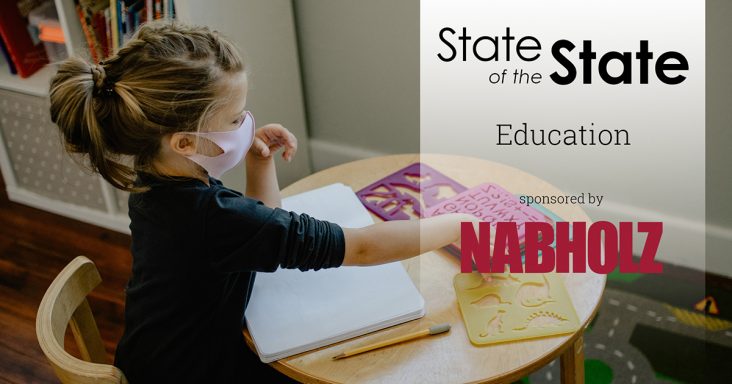Public school changes will be permanent, ‘radical ideas’ could come from legislation
by January 12, 2021 5:47 pm 1,360 views

The year 2020 was like none other in the history of Arkansas public education, and regardless of what happens with the COVID-19 pandemic, things will never get back to “normal.” That’s because the pandemic has shown schools how they can use technology to educate students in innovative ways – and because families have grown accustomed to having choices.
Gov. Asa Hutchinson sent almost half a million public school students home in March because of the pandemic, and they did not return to school that spring semester. Schools and teachers were forced to scramble over a few days’ time to become virtual educators.
Some school districts, such as the Elkins School District in Northwest Arkansas, were well prepared for the change. Three years ago, Elkins became a “one to one” district where every student had a Google Chromebook. The district had invested in instructional software programs and trained teachers to use them. Most families had broadband internet access. But in Star City, a survey found 65% to 70% of patrons lacked broadband access at home. Students there instead were educated using paper assignments. While all of this was happening, 90% of Arkansas school districts, including Elkins and Star City, continued serving meals to students at home.
Hutchinson was determined that schools would reopen this fall. Students could learn in person, at home or through a blended approach. Education Secretary Johnny Key told the Arkansas School Boards Association in December that 64% of students this year are onsite, while 22.3%, or 105,479 students, are studying remotely. Another 13.5% are engaged in a hybrid model. On-site students have had to be flexible. Entire districts have had to shift to remote learning for periods of time because of infections and close contacts.

Key said the models were created so school districts could pivot to at-home instruction if necessary because of the COVID-19 pandemic. However, some patrons will want to continue a blended or remote education. For the upcoming 2021-22 school year, schools must offer 178 days of instruction under the law, but they will be able to continue to offer blended or remote instruction programs as they did this year.
“Even if the pandemic has subsided, we expect there will be parents across the state of Arkansas that feel like this is a good option for them. So we have to be prepared for that,” he said.
The pandemic has resulted in extra expenses for school districts, including technology, personal protective equipment, cleaning supplies and substitute teachers. The Bentonville School District, for example, was spending $70,000 on hand sanitizer as it entered the school year. The Bryant School District bought 35,000 reusable masks for students who didn’t have their own. Hot Springs Lakeside ordered 500 lanyards for students to wear around their necks so they were less likely to misplace their masks. Meanwhile, some districts are losing students whose families decided to homeschool or seek other choices.
To help schools with technology, distance learning, planning, and other expenses, the federal government sent Arkansas almost $129 million as part of the $2 trillion CARES Act passed in March. The Arkansas House and Senate Education committees this year recommended as part of their biennial adequacy report that schools receive a 2.33% increase in per pupil foundation funding, the largest in years. It was included in the governor’s budget that he submitted to legislators in November. The recommendations must be approved by the entire Legislature, which typically happens with relatively little debate. Rep. Bruce Cozart, R-Hot Springs, the chair of the House Education Committee, said lawmakers considered projected state revenue forecasts and cost-of-living increases.
Legislators this year hired Augenblick, Palaich and Associates to complete the state’s first objective and comprehensive educational adequacy study since 2006. The report contained recommendations regarding general policy and school funding matrix items, though it did not include specific funding amounts. It will be used to prepare legislators’ next adequacy report before the 2023 legislative session.
There’s been an increasing sentiment among some legislators that they need more control over funding. Some legislators want to turn the “funding matrix” that determines how much state funding districts receive into a “spending matrix” where schools must spend closer to what legislators allot for each budget item. School districts, however, say they need spending flexibility to meet local needs.
Cozart expects a big push for vouchers that would pay for students to attend school where they want or just keep the money and be homeschooled. School choice ideas are proposed every session, but given the events of the past year, they might get traction this time.
“I see a lot of radical ideas coming,” he said. “I just don’t know what they all are, but I really think … there’s going to be some imaginations really brought way out there.”
Arkansas will receive $800 million for education expenses as a result of the federal coronavirus relief package approved by Congress in late December. The bulk of that money, $558 million, will go to the Elementary and Secondary Education Relief Fund. Of that amount, 90% will go to school districts based on their federal Title 1 funding. Gina Windle, Arkansas Department of Education chief operating officer, said districts will have a lot of control, with some guidelines, over how that money is spent.
Windle said schools could use that money for technology expenses and for re-engaging students as they return to on-site instruction, as examples.
The other 10% will go to the Department of Education. Windle said no decisions have been made as to how the money will be spent, but it could address instructional and learning gaps, purchase personal protective equipment, and provide assistance with vaccinations.
Another $205 million will go to the Higher Education Emergency Relief Fund. Half of that money will go to colleges and universities for COVID-related expenses. The other half will go to emergency aid for students based primarily on eligibility for federal grants based on income.
Finally, the Governor’s Educational Emergency Relief Fund will receive $36 million. Of that amount, $13.5 million can be spent at the governor’s discretion. The rest will go to private schools that can apply for funding with a priority going to low-income schools. That’s a new feature with this spending package. Windle noted the federal package includes a separate $7 billion for nationwide broadband internet access.
